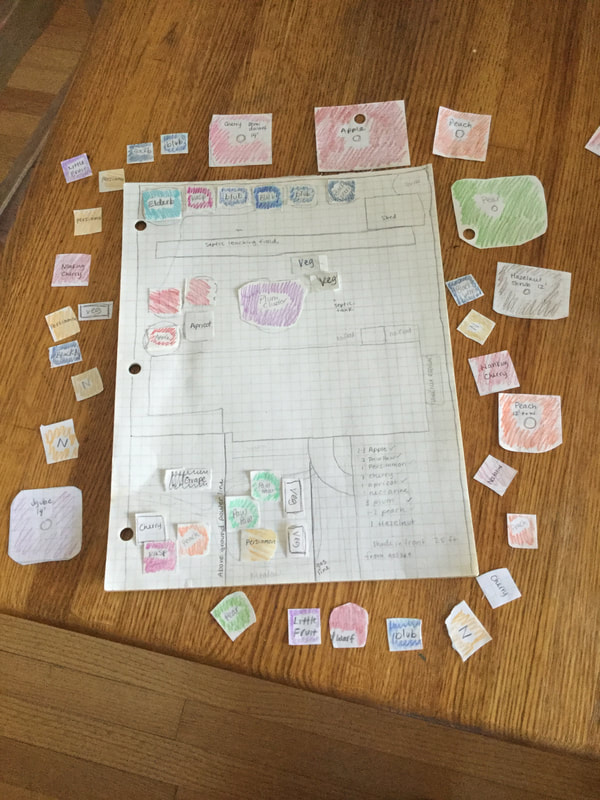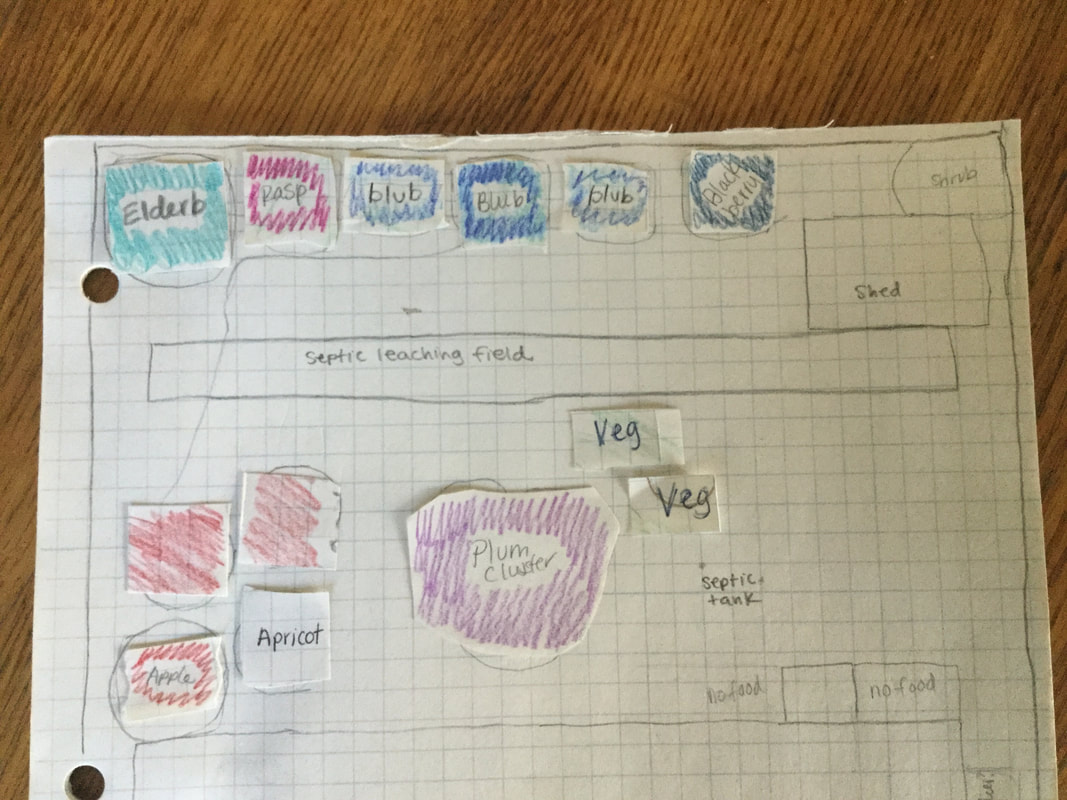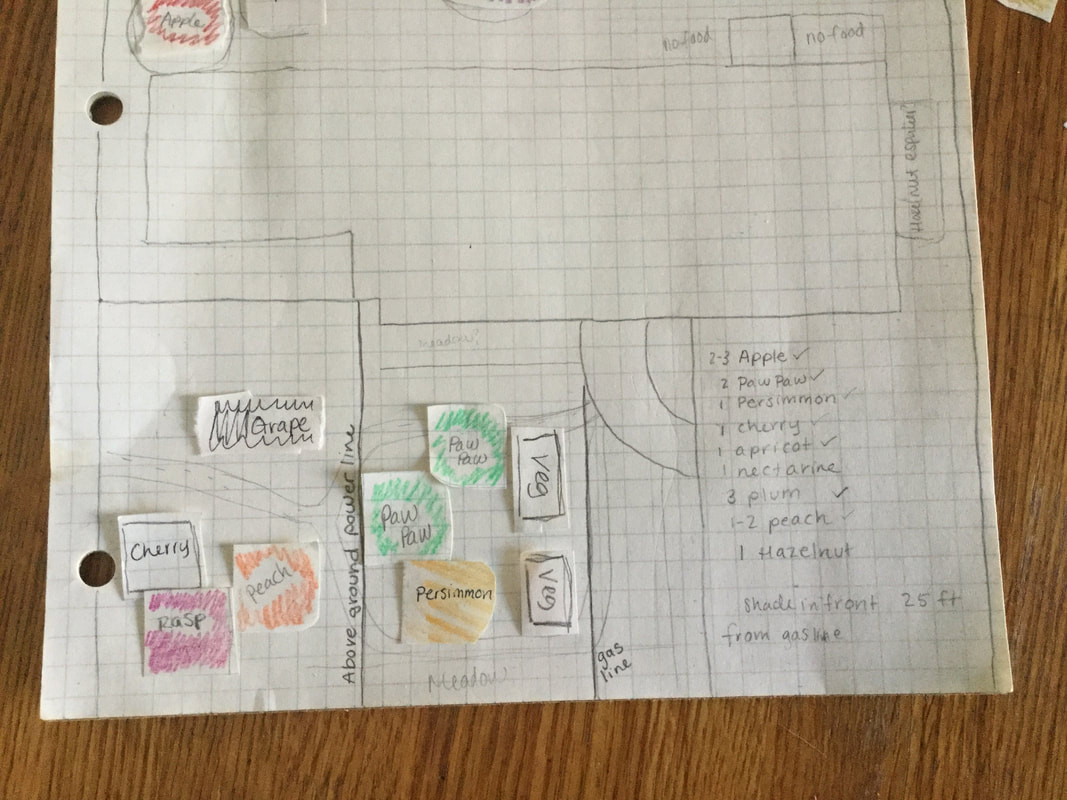|
From early November to Early January I didn’t really do anything with the yard. Wasn’t even interested in it, really. My energy really tanked after moving the final bits of the wood chip pile on Halloween, and I just went inside. It was good to take a break from the project, until doubts crept in. As I huddled on the couch, my brain berated me: “this project is ugly and stupid and what do you know about growing a food forest anyway, and you can’t make a decision about anything”. Well, the whole point of this is that I don’t know that much about growing an integrated vegetable and tree garden. I’ve learned by reading books this year. Anyone can do that. This entire project is meant to prove that an ordinary person can grow food for themselves and for wildlife. It’s designed to inspire you to read the books yourself, or just plant some things and see what happens. So...enough from you, Doubt Brain. (Actually I think doubts are helpful as long as you don’t succumb to them; they make you justify your actions and it feels good to make decisive choices having faced your fears.) I arose from my indifference around the New Year, when my friends were over and asked about my project. I explained my planting plan to them, and showed them what I call my Paper Dolls, which I’ve been using to decide what goes where. They were very excited, and their encouragement got me excited again about my project. I finished my plan, and I want to share it with you. There are my paper dolls! Regular landscape designers create a base map with dark lines and draw shapes for plants on tracing paper over it. I would have used a million sheets of tracing paper; I have moved these darn things around so many times trying to figure out the best arrangement. Sometimes it felt like I was spending too much time on it, but I figure if I'm going to spend a long time on something, it might as well be the planning process. To create the base map, I measured my yard and drew a scale drawing on graph paper. I then cut to-scale squares of the trees and shrubs I was considering including. I colored them to make them beautiful and easy to identify. Oh, and fun to play with. Scale-size trees and shrubs are a low-risk way to see what might fit in your yard. I had a 100 foot Chestnut tree paper doll. Guess who got cut up into smaller trees when she took up the entire yard? I included limitations on my base map: -Septic leaching field in the backyard: no trees or shrubs can go on here, since their roots will potentially damage the system. Raised vegetable beds or a meadow could possibly go on here, but that's another task for another day. -Underground gas line in front: no shrubs within 6 feet, no trees within 25 feet. Once again, this is so that their roots don't damage the line. Paw Paw roots are less aggressive, so I chose to plant those nearest the line. Vegetable and meadow roots are delicate and would not damage the line. -It's not really a limitation, but I sought to include as many native plants as possible. They provide food and habitat for insects and birds. (Read more about this is Doug Tallamy's Bringing Nature Home). It's easy to get carried away with wanting different kinds of fruit trees, but reminding myself to include native plants helped create a final product that's really for everybody. The backyard came together first. Along the back slope will be berries. "Blub" means blueberry, "Elderb" means elderberry. Berries can be unruly, and can spread over the years, especially raspberries and blackberries, so I put them way in back. Currently there is a lilac bush where the elderberry will go, so replacing that is a long-term project. All of these berries are native. I wanted an elderberry a) because they make immune-boosting syrup b) because they feed wildlife and c) because in the Middle Ages, people planted elderberries at the head of their gardens to watch over everything, and I think that’s a lovely idea. Three tiny apple trees and an apricot tree are down the slope near the deck. These are not dwarf trees, which have weak root systems and are generally unhealthy, they are standard fruit trees that will be raring to reach 30 feet tall but I'm going to use a pruning technique to keep them 6 feet tall. None of these types of trees are native. When planning trees, you should plan how they will be watered. Admittedly, I don't have a tight scheme for this right now. These trees will hopefully be watered by a ditch dug next to the sidewalk to harvest the water running down from the rest of the street. I’m at the bottom of a slope, and an incredible amount of water runs by my house to the sewer, and I’m going to try and grab some of it to water my trees. If that doesn't work, I will run drip irrigation. The plum cluster is three trees planted so close together that their branches intermingle. This is the pollination technique recommended by Fedco Tree Catalog. (Pollinating plums is apparently notoriously difficult). I will have two American Plums that I will grow from seed, and one hybrid plum (Santa Rosa) which is bred for larger fruit size and better flavor. The two American Plums will also produce fruit, but it will be smaller, with a flavor determined by the genetic lottery. American plums are host to hundreds and hundreds of insect larvae, which in turn will be excellent food for baby birds. If I lose fruit because of that, fine. "No food" written by the house is a reminder that no food should be grown within three feet of old foundations, due to lead concerns. In the front yard, I have two Paw Paws and a persimmon. All native, all standard-size trees that I will prune to be 6 feet tall. Paw Paws need two individuals for pollination. Typical persimmons need three or more, but I will get a self-fertile one. A grapevine will climb the existing dogwood tree, and a 6-7 foot bush cherry and tiny-pruned peach tree will be in front of that. I drew a faint path just to give myself an idea of how I would move through the yard.
There are still a few unplanned spaces--the side of the house, the back yard in front of the shed. I'll leave those smothered in cardboard and leaves for now, since I've got my work cut out for me. This whole plan will be implemented in Spring and Fall 2020. This plan has come about through copious reading. The absolute best book I read was Creating a Forest Garden: Working with Nature to Grow Edible Crops by Martin Crawford. I've heard that Edible Forest Gardens by Dave Jacke and Eric Toensmeier is very good too. I'll be getting the trees mostly from Fedco Trees mail order. Some will come from Cricket Hill Garden in Thomaston CT, and some will come from Cummins Nursery in upstate New York. All good sources to check for fruit trees. Click here to go to Part II: Understory Plants
0 Comments
Leave a Reply. |
Categories
All
Archives
August 2021
|
Proudly powered by Weebly



 RSS Feed
RSS Feed